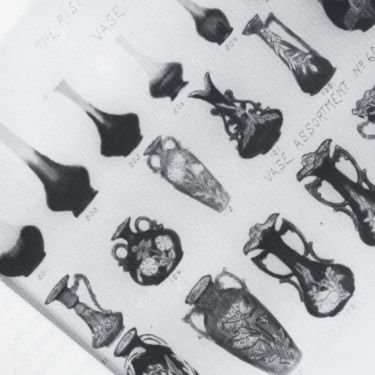
Guide to the Lines Produced by the Roseville Pottery Company
In the 8 years between 1896 and 1904, the Roseville Pottery Company rose from a small local pottery into a national industry. This evolution can be seen easily in the advancement in the wares they produced. Although they produced a wide range of utility ware, collectors most often focus on the art pottery lines.
This period was a time of great flux and experimentation, with artists, potters, and designers coming and leaving at an almost frantic pace, each marking an indelible link in the chain. The production of these pieces was extremely limited, in total produced, designs in line, and duration of production. By later standards, most of these lines would be considered as experimental at best. Few examples of these lines have survived the ensuing one hundred-plus years. Having just one piece of any of these lines is an accomplishment in itself.
-

Victorian Majolica
(1896-1900)
-

Cremo
(1904)
-

Crocus
(1904)
-

Mat Green
(1905)
-

Chloron
(1905)
-

Fujiyama
(1905)
-

Early Della Robbia
(1904)
In 1898, The Roseville Pottery Company purchased their first facilities in Zanesville, Ohio. With this aquisition came a plan to move most of the operations there eventually. Part of this effort was the rebranding of their art pottery lines. The name "Rozane" was chosen, a combination of ROseville and ZANEsville. This term was loosely applied to their Majolica ware of the time, but the first true Rozane ware first appeared in 1900.
Collectors for decades only considered the artist-decorated brown-glazed pieces as Rozane, and later began including those which had wafer Rozane marks applied. These five were Royal, Mara, Woodland, Egypto, and Mongol. Later Olympic was included for the Rozane ink mark often found on the bases. Eventually it became apparent from research of advertisments that Roseville used the term "Rozane" to distinguish their art line from their utilitarion lines. Examples have been found of a wide range of lines from the period bearing a Rozane sticker, finally expanding the use of the term. Today we look at Rozane not as a line, but rather as a period in their production. This period ran roughly from 1900 to around 1907 ending with the departure of Frederick Rhead and the lines that were introduced afterwards by his brother Harry such as Mostique, Donatello, Pauleo, Carnelian, and Velmoss.
-

Rozane Royal
(1900-1907)
-

Rozane Azurean
(1903-1904)
-

Rozane Mongol
(1904-1906)
-

Rozane Mara
(1905-1907)
-

Rozane Aztec
(1904-1905)
-

Rozane Egypto
(1905-1907)
-

Rozane Crystalis
(1906-1907)
-

Rozane Olympic
(1907)
-

Rozane Woodland
(1905-1907)
-

Rozane Fudji
(1906-1907)
-

Rozane Della Robbia
(1906-1907)
If you have more questions, we are certain you will find the answers in the following books. Each of these books is highly recommended for collectors of Roseville Pottery. The owners of this website may receive compensation for qualified sales of the books.




